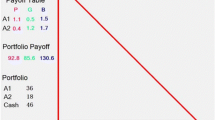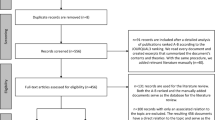Abstract
Several factors affect attitudes toward ambiguity. What happens, however, when people are asked to exchange an ambiguous alternative in their possession for an unambiguous one? We present three experiments in which individuals preferred to retain the former. This status quo bias emerged both within- and between-subjects, with and without incentives, with different outcome distributions, and with endowments determined by both the experimenter and the participants themselves. Findings emphasize the need to account for the frames of reference under which evaluations of probabilistic information take place as well as modifications that should be incorporated into descriptive models of decision making.
Similar content being viewed by others
References
Bar-Hillel, Maya and Efrat Neter (1996). “Why are People Reluctant to Exchange Lottery Tickets?,” Journal of Personality and Social Psychology 70, 17–27.
Becker, Selwin W. and Fred O. Brownson (1964). “What Price Ambiguity? Or the Role of Ambiguity in Decision-Making,” Journal of Political Economy 72, 62–73.
Camerer, Colin F. (1995). Individual Decision Making. In: Kagel J.K. and Roth A.E. (eds.), The Handbook of Experimental Economics. Princeton: Princeton University Press, pp. 587–703.
Camerer, Colin F. and Robin M. Hogarth (1999). “The Effects of Financial Incentives in Experiments: A Review and Capital-Labor-Production Framework,” Journal of Risk and Uncertainty 19, 7–42.
Camerer, Colin F. and Martin Weber (1992). “Recent Developments in Modeling Preferences: Uncertainty and Ambiguity,” Journal of Risk and Uncertainty 5, 325–370.
Chow, Clare C. and Rakesh K. Sarin (2001). “Comparative Ignorance and the Ellsberg Paradox,” Journal of Risk and Uncertainty 22, 129–139.
Chow, Clare C. and Rakesh K. Sarin (2002). “Known, Unknown and Unknowable Uncertainties,” Theory and Decision 52, 127–138.
Cohen, Michele, Jean-Yves Jaffray, and Tanios Said (1985). “Individual Behavior under Risk and under Uncertainty: An Experimental Experiment,” Theory and Decision 50, 360–394.
Curley, Shawn P., Frank Yates, and Richard A. Abrams (1986). “Psychological Sources of Ambiguity Avoidance,” Organizational Behavior and Human Decision Processes 38, 230–256.
Einhorn, Hillel J. and Robin M. Hogarth (1986). “Decision Making under Ambiguity,” Journal of Business 59, 225–250.
Eisenberger, Roselies and Martin Weber (1995). “Willingness-to-Pay and Willingness- To-Accept for Risky and Ambiguous Lotteries,” Journal of Risk and Uncertainty 10, 223–233.
Ellsberg, Daniel (1961). “Risk, Ambiguity and the Savage Axioms,” The Quarterly Journal of Economics 75, 643–669.
Fiedler, Klaus (1988). “The Dependence of the Conjunction Fallacy on Subtle Linguistic Factors,” Psychological Research 50, 123–129.
Fox, Craig R. and Amos Tversky (1995). “Ambiguity Aversion and Comparative Ignorance,” Quarterly Journal of Economics 110, 585–603.
Fox, Craig R. and Martin Weber (2002). “Ambiguity Aversion, Comparative Ignorance and Decision Context,” Organizational Behavior and Human Decision Processes 88, 476–498.
Heath, Chip and Amos Tversky (1991). “Preference and Belief: Ambiguity and Competence in Choice under Uncertainty,” Journal of Risk and Uncertainty 4, 5–28.
Kahn, Barbara and Rakesh K. Sarin (1988). “Modelling Ambiguity in Decisions under Uncertainty,” Journal of Consumer Research 15, 265–272.
Kahneman, Daniel and Amos Tversky (1979). “Prospect Theory: An Analysis of Decision under Risk,” Econometrica 47, 263–291.
Kahneman, Daniel and Amos Tversky (1982). “The Psychology of Preference,” Scientific American 246, 160–291.
Kahneman, Daniel and Amos Tversky (1992). “Advances in Prospect Theory: Cumulative Representation of Uncertainty,” Journal of Risk and Uncertainty 5, 297–324.
Kahneman, Daniel, Jack L. Knetsch, and Richard H. Thaler (1991). “Anomalies: The Endowment Effect, Loss Aversion and Status Quo Bias,” Journal of Economic Perspectives 5, 193–206.
Keren, Gideon and Léonie E. M. Gerritsen (1999). “On the Robustness and Possible Accounts of Ambiguity Aversion,” Acta Psychologica 103, 149–172.
Koehler, Jonathan J., Brian J. Gibbs, and Robin M. Hogarth (1994). “Shattering the Illusion of Control: Multi-shot versus Single-shot Gambles,” Journal of Behavioral Decision Making 7, 183–191.
Langer, Ellen J. (1975). “The Illusion of Control,” Journal of Personality and Social Psychology 32, 311–328.
LeBoeuf, Robyn A. and Eldar Shafir (2003). “Deep Thoughts and Shallow Frames: Effortful Thinking and Susceptibility to Framing Effects,” Journal of Behavioral Decision Making 16, 77–92.
Loewenstein, George and Samuel Issacharoff (1994). “Source Dependence in the Valuation of Objects,” Journal of Behavioral Decision Making 7, 157–68.
Mukerji, Sujoy and Jean-Marc Tallon (2001). “Ambiguity Aversion and Incompleteness of Financial Markets,” Review of Economic Studies 68, 883–904.
Raiffa, Howard (1961). “Risk, Ambiguity, and the Savage Axioms: Comment,” The Quarterly Journal of Economics 75, 690–694.
Samuelson, William and Richard Zeckhauser (1988). “Status Quo Bias in Decision Making,” Journal of Risk and Uncertainty 1, 7–59.
Shafir, Eldar (1993). “Choosing versus Rejecting: Why some Options Are Both Better and Worse than Others,” Memory and Cognition 21, 546–556.
Shafir, Eldar, Itamar Simonson, and Amos Tversky (1993). “Reason-Based Choice,” Cognition 49, 1–36.
Smith, Kip, John Dickhaut, Kevin McCabe, and Jose V. Pardo (2002). “Neuronal Substrates for Choice under Ambiguity, Risk, Gains, and Losses,” Management Science 48, 711–718.
Thaler, Richard H. (1980). “Toward a Positive Theory of Consumer Choice,” Journal of Economic Behavior and Organization 1, 39–60.
Tversky, Amos and Daniel Kahneman (1986). “Rational Choice and the Framing of Decisions,” Journal of Business 59, s251–s278.
Viscusi, W. Kip, Wesley A. Magat, and Joel Huber (1987). “An Investigation of the Rationality of Consumer Valuations of Multiple Health Risks,” RAND Journal of Economics 18, 465–479.
Yates, J. Frank and Lisa G. Zukowski (1976). “Characterization of Ambiguity in Decision Making,” Behavioral Science 21, 19–25.
Author information
Authors and Affiliations
Corresponding author
Additional information
JEL Classification C91 · D81
Rights and permissions
About this article
Cite this article
Roca, M., Hogarth, R.M. & Maule, A.J. Ambiguity seeking as a result of the status quo bias. J Risk Uncertainty 32, 175–194 (2006). https://doi.org/10.1007/s11166-006-9518-8
Issue Date:
DOI: https://doi.org/10.1007/s11166-006-9518-8




